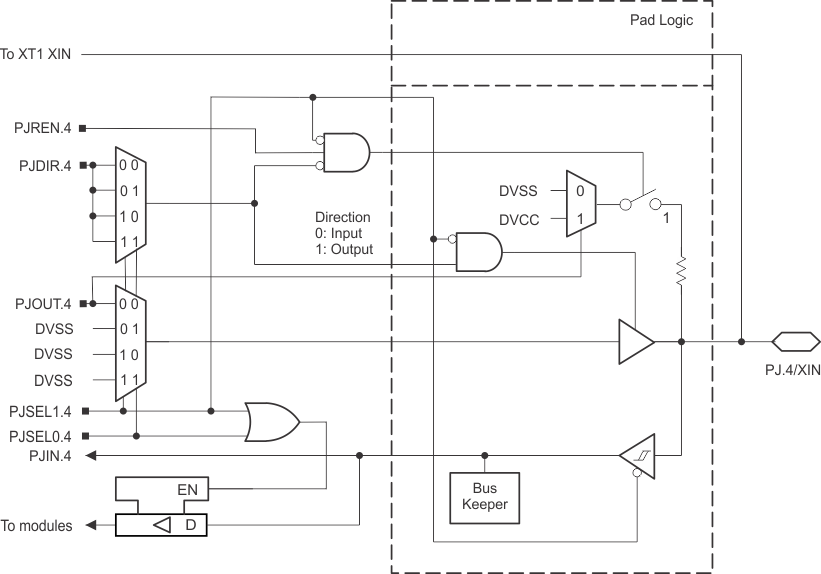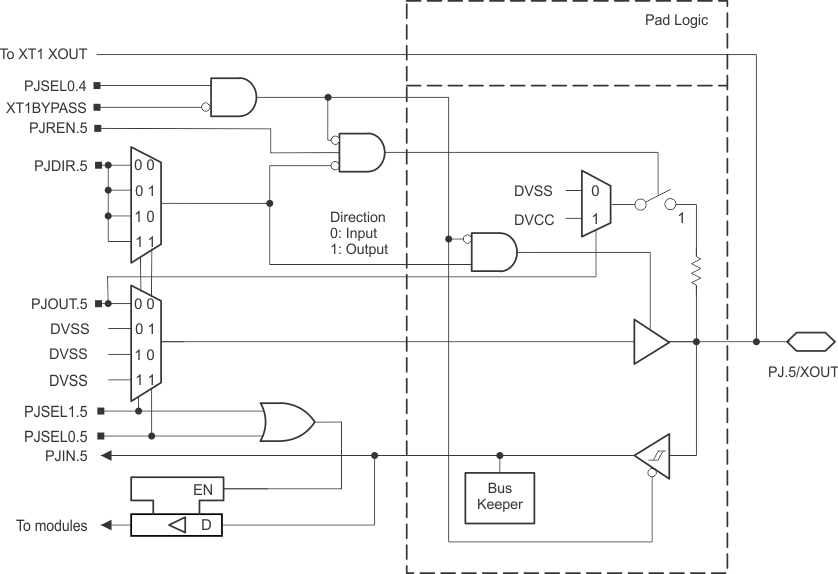ZHCS180L July 2011 – December 2017 MSP430FR5730 , MSP430FR5731 , MSP430FR5732 , MSP430FR5733 , MSP430FR5734 , MSP430FR5735 , MSP430FR5736 , MSP430FR5737 , MSP430FR5738 , MSP430FR5739
PRODUCTION DATA.
- 1器件概述
- 2修订历史记录
- 3Device Comparison
-
4Terminal Configuration and Functions
- 4.1 Pin Diagram – RHA Package – MSP430FR5731, MSP430FR5733, MSP430FR5735, MSP430FR5737, MSP430FR5739
- 4.2 Pin Diagram – DA Package – MSP430FR5731, MSP430FR5733, MSP430FR5735, MSP430FR5737, MSP430FR5739
- 4.3 Pin Diagram – RGE Package – MSP430FR5730, MSP430FR5732, MSP430FR5734, MSP430FR5736, MSP430FR5738
- 4.4 Pin Diagram – YQD Package – MSP430FR5738
- 4.5 Pin Diagram – PW Package – MSP430FR5730, MSP430FR5732, MSP430FR5734, MSP430FR5736, MSP430FR5738
- 4.6 Signal Descriptions
-
5Specifications
- 5.1 Absolute Maximum Ratings
- 5.2 ESD Ratings
- 5.3 Recommended Operating Conditions
- 5.4 Active Mode Supply Current Into VCC Excluding External Current
- 5.5 Low-Power Mode Supply Currents (Into VCC) Excluding External Current
- 5.6 Thermal Resistance Characteristics
- 5.7 Schmitt-Trigger Inputs – General-Purpose I/O (P1.0 to P1.7, P2.0 to P2.7, P3.0 to P3.7, P4.0 to P4.1, PJ.0 to PJ.5, RST/NMI)
- 5.8 Inputs – Ports P1 and P2 (P1.0 to P1.7, P2.0 to P2.7)
- 5.9 Leakage Current – General-Purpose I/O (P1.0 to P1.7, P2.0 to P2.7, P3.0 to P3.7, P4.0 to P4.1, PJ.0 to PJ.5, RST/NMI)
- 5.10 Outputs – General-Purpose I/O (P1.0 to P1.7, P2.0 to P2.7, P3.0 to P3.7, P4.0 to P4.1, PJ.0 to PJ.5)
- 5.11 Output Frequency – General-Purpose I/O (P1.0 to P1.7, P2.0 to P2.7, P3.0 to P3.7, P4.0 to P4.1, PJ.0 to PJ.5)
- 5.12 Typical Characteristics – Outputs
- 5.13 Crystal Oscillator, XT1, Low-Frequency (LF) Mode
- 5.14 Crystal Oscillator, XT1, High-Frequency (HF) Mode
- 5.15 Internal Very-Low-Power Low-Frequency Oscillator (VLO)
- 5.16 DCO Frequencies
- 5.17 MODOSC
- 5.18 PMM, Core Voltage
- 5.19 PMM, SVS, BOR
- 5.20 Wake-up Times From Low-Power Modes
- 5.21 Timer_A
- 5.22 Timer_B
- 5.23 eUSCI (UART Mode) Clock Frequency
- 5.24 eUSCI (UART Mode)
- 5.25 eUSCI (SPI Master Mode) Clock Frequency
- 5.26 eUSCI (SPI Master Mode)
- 5.27 eUSCI (SPI Slave Mode)
- 5.28 eUSCI (I2C Mode)
- 5.29 10-Bit ADC, Power Supply and Input Range Conditions
- 5.30 10-Bit ADC, Timing Parameters
- 5.31 10-Bit ADC, Linearity Parameters
- 5.32 REF, External Reference
- 5.33 REF, Built-In Reference
- 5.34 REF, Temperature Sensor and Built-In VMID
- 5.35 Comparator_D
- 5.36 FRAM
- 5.37 JTAG and Spy-Bi-Wire Interface
-
6Detailed Description
- 6.1 Functional Block Diagrams
- 6.2 CPU
- 6.3 Operating Modes
- 6.4 Interrupt Vector Addresses
- 6.5 Memory Organization
- 6.6 Bootloader (BSL)
- 6.7 JTAG Operation
- 6.8 FRAM
- 6.9 Memory Protection Unit (MPU)
- 6.10
Peripherals
- 6.10.1 Digital I/O
- 6.10.2 Oscillator and Clock System (CS)
- 6.10.3 Power-Management Module (PMM)
- 6.10.4 Hardware Multiplier (MPY)
- 6.10.5 Real-Time Clock (RTC_B)
- 6.10.6 Watchdog Timer (WDT_A)
- 6.10.7 System Module (SYS)
- 6.10.8 DMA Controller
- 6.10.9 Enhanced Universal Serial Communication Interface (eUSCI)
- 6.10.10 TA0, TA1
- 6.10.11 TB0, TB1, TB2
- 6.10.12 ADC10_B
- 6.10.13 Comparator_D
- 6.10.14 CRC16
- 6.10.15 Shared Reference (REF)
- 6.10.16 Embedded Emulation Module (EEM)
- 6.10.17 Peripheral File Map
- 6.11
Input/Output Diagrams
- 6.11.1 Port P1 (P1.0 to P1.2) Input/Output With Schmitt Trigger
- 6.11.2 Port P1 (P1.3 to P1.5) Input/Output With Schmitt Trigger
- 6.11.3 Port P1 (P1.6 and P1.7) Input/Output With Schmitt Trigger
- 6.11.4 Port P2 (P2.0 to P2.2) Input/Output With Schmitt Trigger
- 6.11.5 Port P2 (P2.3 and P2.4) Input/Output With Schmitt Trigger
- 6.11.6 Port P2 (P2.5 and P2.6) Input/Output With Schmitt Trigger
- 6.11.7 Port P2 (P2.7) Input/Output With Schmitt Trigger
- 6.11.8 Port P3 (P3.0 to P3.3) Input/Output With Schmitt Trigger
- 6.11.9 Port P3 (P3.4 to P3.6) Input/Output With Schmitt Trigger
- 6.11.10 Port Port P3 (P3.7) Input/Output With Schmitt Trigger
- 6.11.11 Port Port P4 (P4.0) Input/Output With Schmitt Trigger
- 6.11.12 Port Port P4 (P4.1) Input/Output With Schmitt Trigger
- 6.11.13 Port Port PJ (PJ.0 to PJ.3) JTAG Pins TDO, TMS, TCK, TDI/TCLK, Input/Output With Schmitt Trigger or Output
- 6.11.14 Port Port PJ (PJ.4 and PJ.5) Input/Output With Schmitt Trigger
- 6.12 Device Descriptors (TLV)
- 7器件和文档支持
- 8机械、封装和可订购信息
封装选项
机械数据 (封装 | 引脚)
散热焊盘机械数据 (封装 | 引脚)
- RGE|24
订购信息
6.11.14 Port Port PJ (PJ.4 and PJ.5) Input/Output With Schmitt Trigger
Figure 6-23 and Figure 6-24 show the port diagrams. Table 6-52 summarizes the selection of the pin functions.
Table 6-52 Port PJ (PJ.4 and PJ.5) Pin Functions
| PIN NAME (P7.x) | x | FUNCTION | CONTROL BITS OR SIGNALS (1) | |||||
|---|---|---|---|---|---|---|---|---|
| PJDIR.x | PJSEL1.5 | PJSEL0.5 | PJSEL1.4 | PJSEL0.4 | XT1 BYPASS | |||
| PJ.4/XIN | 4 | PJ.4 (I/O) | I: 0; O: 1 | X | X | 0 | 0 | X |
| XIN crystal mode (2) | X | X | X | 0 | 1 | 0 | ||
| XIN bypass mode (2) | X | X | X | 0 | 1 | 1 | ||
| PJ.5/XOUT | 5 | PJ.5 (I/O) | I: 0; O: 1 | 0 | 0 | 0 | 0 | X |
| XOUT crystal mode (2) | X | X | X | 0 | 1 | 0 | ||
| PJ.5 (I/O) (3) | I: 0; O: 1 | X | X | 0 | 1 | 1 | ||
(1) X = Don't care
(2) Setting PJSEL1.4 = 0 and PJSEL0.4 = 1 causes the general-purpose I/O to be disabled. When XT1BYPASS = 0, PJ.4 and PJ.5 are configured for crystal operation and PJSEL1.5 and PJSEL0.5 are don't care. When XT1BYPASS = 1, PJ.4 is configured for bypass operation and PJ.5 is configured as general-purpose I/O.
(3) When PJ.4 is configured in bypass mode, PJ.5 is configured as general-purpose I/O.

